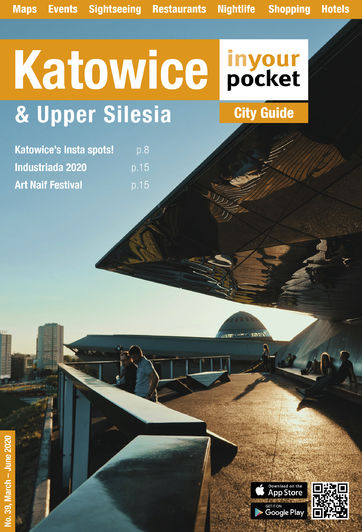Welcome dear reader to one of Silesia’s most interesting and indeed historical cities. The times are indeed changing and the city is growing into a more modern version of itself as it slowly but surely shakes off the shackles of its industrial past. Much sets Gliwice apart from other cities in the Upper Silesian Metropolitan area, but perhaps nothing more than its historic cultural centre with a proper Rynek (Market Square) as its nucleus. The centre is surrounded by a wealth of spires, monuments, fountains and turn of the century masterpieces. Certainly, Kraków this aint, but a journey from Katowice to Gliwice, though it won't overwhelm you, is still likely to summon the declaration, 'Alright, this is a bit more like it.' If you’re searching for a diamond amongst the debris and dross of the sometimes depressing Silesian landscape, you’ll find yourselves richly rewarded in Gliwice. Besides the various museums and landmarks to explore there is a bevvy of new bars, cafes and restaurants to explore so pull up your boots and pull a Gulliver through Gliwice.
One significant leg Gliwice has up on its neighbours is history. Some 500 years before even a hundred families had made the communal mistake of moving to Katowice, Gliwice was building fortifications around its already well-developed medieval city centre. Today traces of the city's ancient past can be seen in the 14th century defensive walls along Plac Rzeźniczy and ul. Grodowa, and Piast's Castle which now houses a branch of the Gliwice's well put together city museum.
Gliwice's primary historical claim to fame didn't come until modern times however. Most with even a cursory knowledge of 20th century history can tell you that the first shots of WWII were fired on Westerplatte, a peninsula outside Gdańsk in northern Poland. But only the most committed boffin can claim to know the story of Hitler's spurious excuse to launch his offensive into PL. That narrative can be found here, in little Gliwice, which at that time was a border town under German rule known to locals as 'Gleiwitz.' Looking to legitimise his intended hostile takeover of Poland, Hitler crafted a mock attack - today known as the 'Gleiwitz Incident' - on the Gliwice Radio Tower, using SS officers impersonating Polish military. On the evening of August 31, 1939, SS troops stormed the tower, locked the German staff in the basement, and broadcast a chaotic message of insurrection in Polish over the airwaves while firing shots into the ceiling. They then took Franciszek Honiok - an unfortunate ethnic Pole who would be playing the role of German victim - out back and shot him, and prepared other 'evidence' for the German press who ran with the bogus story in the morning. Hitler had the perfect pretext to roll his troops eastwards into Poland, and the rest, as they say, is history - of which you can learn more at the Gliwice Radio Tower Museum (ul. Tarnogórska 129).
Thanks to the discovery of mining minerals in the area, at the turn of the century Gliwice's population had grown to over 60,000, with the city home to four catholic churches, two protestant and one synagogue. Facing Pl. Inwalidów, the synagogue came to a fiery end when it was torched on Kristallnacht in 1938, and over the course of the next several years the town's Jewish population was decimated as part of the Nazis' ‘final solution’. Today traces of Jewish heritage are limited to two overgrown cemeteries on ul. Na Piasku and ul. Poniatowskiego. Dating from 1815 and 1902 respectively, the two now stand as haunting and poignant epitaphs to the past.
Though it was one of only three Silesian cities (along with Bytom and Zabrze) to have remained in German hands after WWI, Gliwice was transferred to the map of Poland in 1945 after the Second World War, the Germans were purged and the town was re-christened. The post-war Polonisation of Gliwice saw the city emerge as an important centre of science, with the town frequently finding itself dubbed as the ‘chemical capital of Poland’. Yet for all this, and the communist mismanagement that followed WWII, modern day Gliwice is surprisingly easy on the eye and makes a pleasing diversion from Katowice. A wander about the ancient streets of the Old Town reveals a large number of bars and restaurants well worth investigation, and Gliwice boasts a solid live music scene for a city of its size; don't be afraid to let the nightlife - which arguably rivals that of Katowice - extend your visit. Lastly, if you've the good fortune of amicable weather, a day spent in Chopin Park is always a pleasure with the Palm House standing out as its primary highlight.
Introducing Gliwice
Refine your search
Choose Categories
Gliwice Cafes
Gliwice Cultural Venues
Gliwice Restaurants
Gliwice Nightlife
Gliwice Sightseeing
Gliwice Hotels
Choose Amenities
Air-conditioning
Child-friendly
Conference facilities
Credit Cards
Dogs Allowed
Facilities for disabled
Fitness centre
Guarded parking
Home Delivery
Live Music
No Credit cards
Outside seating
Restaurant
Sauna
Smoking place
Takeaway
Wi-fi
Submit
Associated Venues
/katowice/kolejkowo-a-wonderful-world-in-miniature_156796v
All aboard! All aboard now! Okay, you may not quite fit onto your train here, but at least you won't miss it and you can follow its path as it winds through a …


